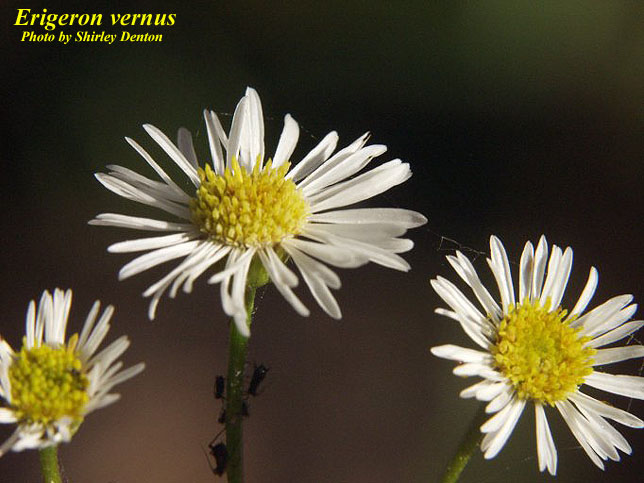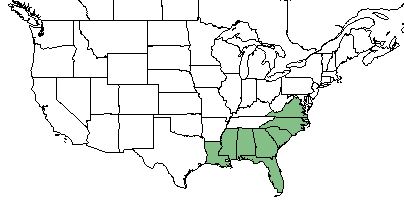Difference between revisions of "Erigeron vernus"
(→Ecology) |
(→Ecology) |
||
| Line 32: | Line 32: | ||
==Ecology== | ==Ecology== | ||
===Habitat=== <!--Natural communities, human disturbed habitats, topography, hydrology, soils, light, fire regime requirements for removal of competition, etc.--> | ===Habitat=== <!--Natural communities, human disturbed habitats, topography, hydrology, soils, light, fire regime requirements for removal of competition, etc.--> | ||
| − | ''E. vernus'' proliferates in wet savannas, seepages, and interdunal swales. <ref name= "Weakley 2015"> Weakley, A. S. (2015). Flora of the Southern and Mid-Atlantic States. Chapel Hill, NC, University of North Carolina Herbarium. </ref> | + | ''E. vernus'' proliferates in wet savannas, seepages, and interdunal swales. <ref name= "Weakley 2015"> Weakley, A. S. (2015). Flora of the Southern and Mid-Atlantic States. Chapel Hill, NC, University of North Carolina Herbarium. </ref> Specimens have been collected from edge of pond, dry loamy sands, wet pine flatwoods, hardwood swamp, peaty ditch, cypress swamp, prairie, hillside bog, and disturbed areas such as next to a track field and roadside ditches. <ref name = "FSU herbarium"> URL: http://herbarium.bio.fsu.edu. Last accessed: June 2018. Collectors: Ed Keppner, Lisa Keppner, Loran C. Anderson, Cecil Slaughter, R. Kral, Ann F. Johnson, R.K. Godfrey, Morris Adams, A.F. Clewell, E. Tyson, Paul L. Redfearn, Robert Norris, Bruce Hansen, JoAnn Hansen, D.W. Mather, Lloyd H. Shinners, Grady Reinert, N. Summerlin, M. Knott, J.P. Gillespie, W.D. Reese, E.M. Hodgson, C.Jackson, Gerould Wilhelm, Mabel Kral, George Cooley, Richard Eaton, James D. Ray, K. Craddock Burks, R. Komarek, J.M. Kane. States and counties: Florida (Bay, Wakulla, Putnam, Flagler, Nassau, Franklin, Liberty, Volusia, Washington, Walton, Hamilton, Jefferson, Okaloosa, Marion, Escambia, Osceola, Calhoun, Union, Jackson, Bradford, Charlotte, Martin, Citrus, Dixie, Jefferson) Georgia (Thomas)</ref> |
===Phenology=== <!--Timing off flowering, fruiting, seed dispersal, and environmental triggers. Cite PanFlora website if appropriate: http://www.gilnelson.com/PanFlora/ --> | ===Phenology=== <!--Timing off flowering, fruiting, seed dispersal, and environmental triggers. Cite PanFlora website if appropriate: http://www.gilnelson.com/PanFlora/ --> | ||
''E. vernus'' flowers January-July and September. <ref name= "PanFlora"> PanFlora Author: Gil Nelson URL: [http://www.gilnelson.com/PanFlora/ http://www.gilnelson.com/PanFlora/] Date Accessed: 5/21/18 </ref> | ''E. vernus'' flowers January-July and September. <ref name= "PanFlora"> PanFlora Author: Gil Nelson URL: [http://www.gilnelson.com/PanFlora/ http://www.gilnelson.com/PanFlora/] Date Accessed: 5/21/18 </ref> | ||
Revision as of 17:32, 28 June 2018
Common name: early whitetop fleabane [1], whitetop fleabane [2]
| Erigeron vernus | |
|---|---|

| |
| Photo by the Atlas of Florida Plants Database | |
| Scientific classification | |
| Kingdom: | Plantae |
| Division: | Magnoliophyta - Flowering plants |
| Class: | Magnoliopsida - Dicots |
| Order: | Asterales |
| Family: | Asteraceae |
| Genus: | Erigeron |
| Species: | E. vernus |
| Binomial name | |
| Erigeron vernus L | |

| |
| Natural range of Erigeron vernus from USDA NRCS Plants Database. | |
Contents
Taxonomic Notes
Synonyms: none
Varieties: none
Description
E. vernus is a perennial forb/herb of the Asteraceae family native to North America. [1]
Distribution
E. vernus is found along the southeastern coast of the United States from Louisiana to Virginia. [1]
Ecology
Habitat
E. vernus proliferates in wet savannas, seepages, and interdunal swales. [2] Specimens have been collected from edge of pond, dry loamy sands, wet pine flatwoods, hardwood swamp, peaty ditch, cypress swamp, prairie, hillside bog, and disturbed areas such as next to a track field and roadside ditches. [3]
Phenology
E. vernus flowers January-July and September. [4]
Use by animals
E. vernus has poor forage value. [5]
Conservation and Management
Cultivation and restoration
Photo Gallery
References and notes
- ↑ 1.0 1.1 1.2 USDA Plant Database https://plants.usda.gov/core/profile?symbol=ERVE
- ↑ 2.0 2.1 Weakley, A. S. (2015). Flora of the Southern and Mid-Atlantic States. Chapel Hill, NC, University of North Carolina Herbarium.
- ↑ URL: http://herbarium.bio.fsu.edu. Last accessed: June 2018. Collectors: Ed Keppner, Lisa Keppner, Loran C. Anderson, Cecil Slaughter, R. Kral, Ann F. Johnson, R.K. Godfrey, Morris Adams, A.F. Clewell, E. Tyson, Paul L. Redfearn, Robert Norris, Bruce Hansen, JoAnn Hansen, D.W. Mather, Lloyd H. Shinners, Grady Reinert, N. Summerlin, M. Knott, J.P. Gillespie, W.D. Reese, E.M. Hodgson, C.Jackson, Gerould Wilhelm, Mabel Kral, George Cooley, Richard Eaton, James D. Ray, K. Craddock Burks, R. Komarek, J.M. Kane. States and counties: Florida (Bay, Wakulla, Putnam, Flagler, Nassau, Franklin, Liberty, Volusia, Washington, Walton, Hamilton, Jefferson, Okaloosa, Marion, Escambia, Osceola, Calhoun, Union, Jackson, Bradford, Charlotte, Martin, Citrus, Dixie, Jefferson) Georgia (Thomas)
- ↑ PanFlora Author: Gil Nelson URL: http://www.gilnelson.com/PanFlora/ Date Accessed: 5/21/18
- ↑ Hilmon, J. B. (1964). "Plants of the Caloosa Experimental Range " U.S. Forest Service Research Paper SE-12